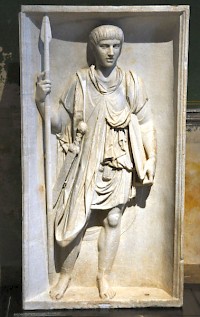Praetorian prefect
Praetorian prefect: Roman official, responsible for the imperial guard and the administration of justice.

This office was created by the emperor Augustus, who placed men of the equestrian order in charge of the praetorian cohorts, i.e., his personal guard. The man was called a prefect, a title usually used to describe an official who was appointed for a fixed period and with a special, military task (mandatum). During the following centuries, the number of commanders was sometimes one (a.o. under Tiberius), sometimes two, and under Commodus perhaps even three.
The praetorian prefect had other responsibilities as well. For example, he could be asked to command troops that were (temporarily) garrisoned in Italy, like the Second Parthian Legion that had been created by the emperor Septimius Severus. In the course of the third century, the legions outside Italy were added.
In peace time, the praetorian prefect had certain juridical duties; from Tiberius on, he had to persecute people who were charged with lese majesty and high treason. In the second century, the praetorian prefect was without any doubt in the first place a judge, his military tasks being of secondary importance.

In the third century, the praetorian prefect was responsible for appeals against provincial governors, was chairman of a special court, and was a member of the consilium principis (the emperor's advisory board). His judgments were considered to be made by the emperor in person, which meant that appeal was impossible. At this time, the praetorian prefect was probably also responsible for the Second Legion Parthica, which was garrisoned in Alba near Rome.
Praetorian prefects were regarded as the second man in the empire, and many of them became famous or notorious: Seianus under Tiberius, Burrus under Nero, and Plautianus under Septimius Severus. The emperors Titus, Macrinus, Philippus Arabs, and Carus served as praetorian prefect before they accepted the imperial purple.